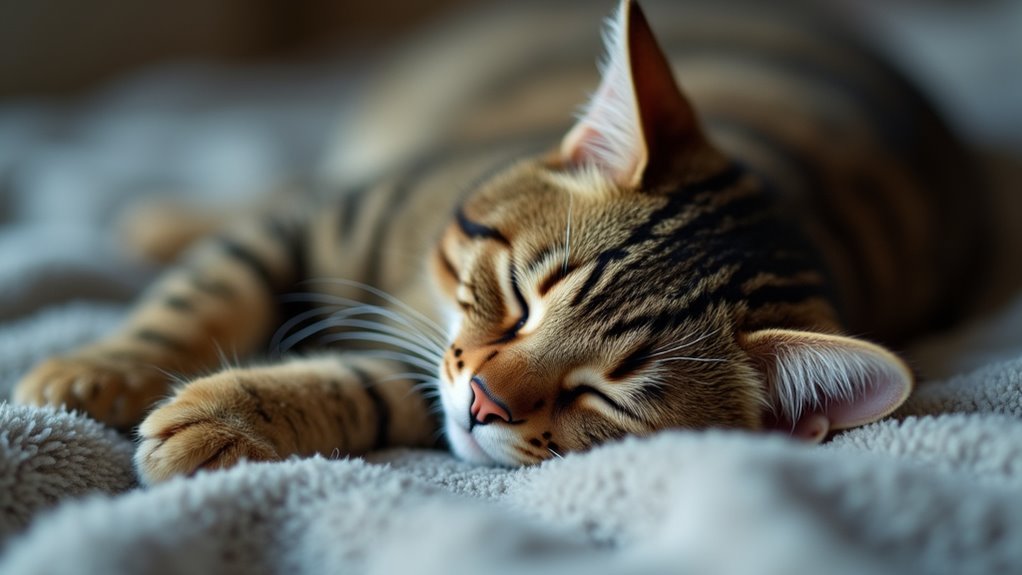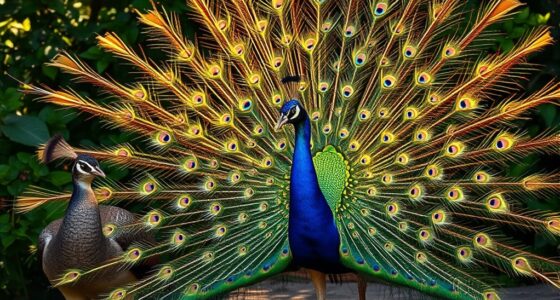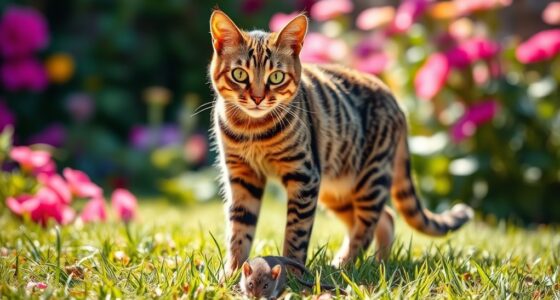Animals definitely dream, as they experience REM sleep, a stage linked to vivid dreaming in humans. During this sleep phase, their brains are highly active, and behaviors like twitching, vocalizing, or movement suggest they are reliving experiences or processing memories. Many species, from dolphins to dogs, show sleep patterns and brain activity similar to humans, indicating they have inner mental worlds. If you keep exploring, you’ll discover fascinating insights into how animals’ dreams reveal their complex consciousness.
Key Takeaways
- Many animals experience REM sleep, indicating they likely dream during this active sleep phase.
- Physical signs like twitching and vocalizations during sleep suggest vivid dreaming in animals.
- Brain activity patterns during sleep resemble human REM sleep, supporting the idea of internal mental experiences.
- Evidence from behavioral studies shows animals may process memories, emotions, or scenarios while sleeping.
- The widespread presence of REM sleep across species points to animals sharing the capacity for dreaming.

Have you ever wondered if animals dream like humans do? It’s a fascinating question that taps into the depths of animal consciousness. While we can’t ask our pets or wild creatures directly, scientific studies suggest that many animals experience sleep cycles similar to ours, which makes the idea of them dreaming quite plausible. When you observe a dog twitching in its sleep or a cat purring softly, you might be witnessing the physical signs of vivid dreams. Researchers have explored sleep cycle analysis to better understand these phenomena. They’ve discovered that many animals exhibit REM (Rapid Eye Movement) sleep, a stage strongly linked to dreaming in humans. During REM sleep, the brain is highly active, and the body’s muscles are temporarily paralyzed — a state that’s essential for dreaming to occur without physical movement.
Animals exhibit REM sleep, suggesting they likely dream much like humans do.
Animal consciousness plays an essential role here. It’s the foundation that indicates whether animals are aware of their experiences and capable of processing complex mental states like dreaming. While animal consciousness isn’t fully understood, evidence from behavioral studies and neurological research points toward a level of awareness that’s deeper than mere reflexes. For example, dolphins and elephants show signs of self-awareness, and their sleep patterns further support the idea that they experience some form of dreaming. When their brain activity during sleep mirrors human REM patterns, it suggests they are processing memories, emotions, or scenarios internally—hallmarks of dreaming. Additionally, understanding sleep cycles in animals helps scientists learn more about the evolution of consciousness and mental processes.
As you observe your pet sleeping, you might notice subtle movements, tail twitching, or even seemingly vocalizations. These signs are often interpreted as indicators of dreaming, especially when linked with brain activity patterns seen in sleep cycle analysis. In the wild, animals like lions or wolves also go through similar sleep phases, which implies that dreaming isn’t limited to humans or domesticated pets. Instead, it might be a widespread phenomenon across the animal kingdom, serving functions like memory consolidation or problem-solving. Furthermore, recent neurological studies have shown that the brain activity of animals during REM sleep closely resembles human patterns, reinforcing the idea of shared mental experiences. Understanding these sleep cycles and what they reveal about animal consciousness deepens your appreciation of your pets and wildlife alike. It’s incredible to think that behind those closed eyes, animals could be reliving hunts, exploring new territories, or recalling social interactions. Although there’s still much to learn, current research indicates that animals do indeed dream, sharing a complex inner life that’s remarkably similar to ours in many ways. Recognizing this not only enriches your bond with animals but also highlights their capacity for mental experiences, making their sleep a window into their rich inner worlds.
Frequently Asked Questions
Do Animals Dream Differently From Humans?
You might wonder if animals dream differently from humans. In comparative sleep studies, scientists observe that many animals experience REM sleep, where dreams occur. While their dreams may focus on survival or daily activities, their dream evolution suggests some similarities. You can imagine that animals’ dreams are simpler or more instinct-driven, but they still reflect their experiences. So, yes, animals likely dream differently, shaped by their unique biology and life needs.
Can Animals Experience Nightmares?
Ever wonder if your pet’s dreams include terrifying squirrel chases or feline nightmares? You definitely can’t ask them, but their sleep patterns hint they might experience nightmares. With limited dream recall, animals probably have nightmare frequency, though less vividly than humans. So next time your dog whimpers in sleep, remember—maybe they’re reliving that rough day at the park, or maybe they’re just dreaming of chasing cats.
How Do Scientists Study Animal Dreams?
Scientists study animal dreams by using neuroscience breakthroughs and dream research methods. You might find that they track brain activity during sleep, especially during rapid eye movement (REM) sleep, when dreaming occurs. By placing electrodes on animals, researchers can observe neural patterns similar to humans’ dreaming states. This approach helps you understand how animals process experiences and whether they dream, revealing fascinating insights into their minds.
Do Wild Animals Dream More Than Domesticated Ones?
You might think wild animals dream more because they face danger and adventure daily, but domestication effects tell a different story. While wild animals have intense animal sleep patterns and need more REM sleep, domesticated pets often dream just as much or more, thanks to their relaxed routines. So, whether in the wild or at home, animals likely dream equally, with their sleep patterns shaped by their environments and lifestyles.
What Emotions Do Animals Feel During Dreams?
When considering what emotions animals feel during dreams, you should recognize that their animal consciousness likely involves emotional recall. This means they may relive experiences, feeling happiness, fear, or even anxiety during sleep. You can’t know for sure, but evidence suggests animals experience a range of emotions similar to humans, giving you insight into their inner world and highlighting their complex emotional lives during dreams.
Conclusion
So, now you know that animals do dream, revealing a hidden world behind their sleepy eyes. Their dreams show that they share more with us than we might think, connecting us in ways words can’t capture. Remember, just like a book with many chapters, their sleep stories are part of a larger tale of life and instinct. Keep watching, and you might just catch a glimpse of their secret nighttime adventures.









